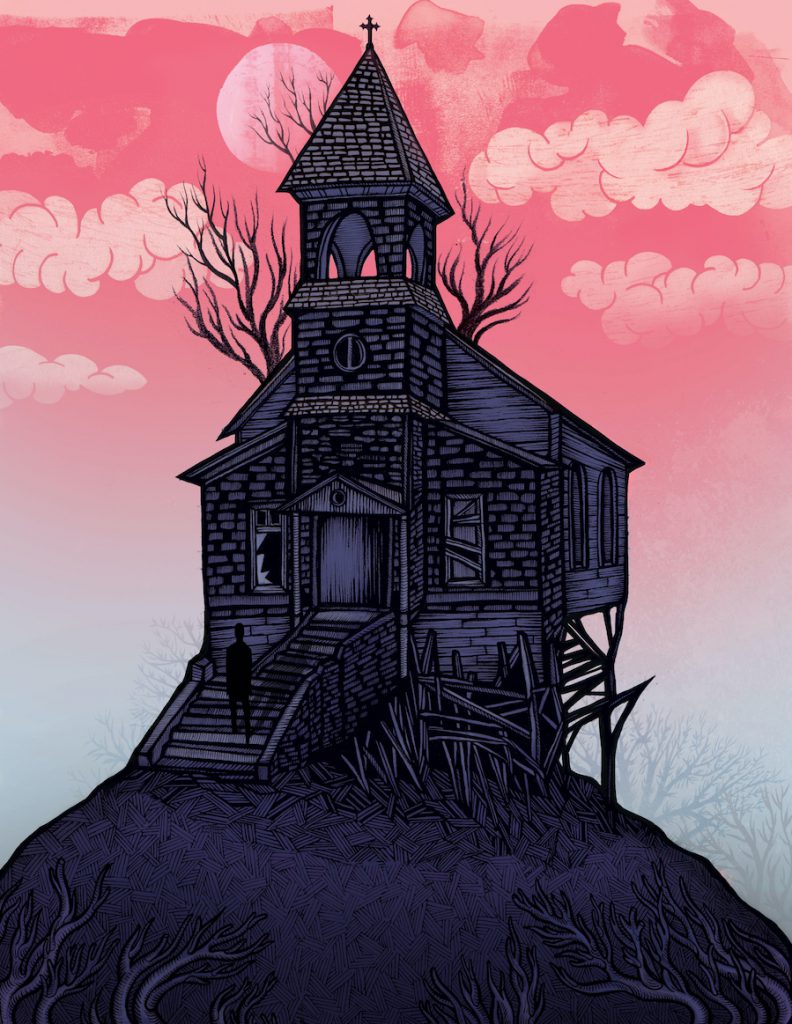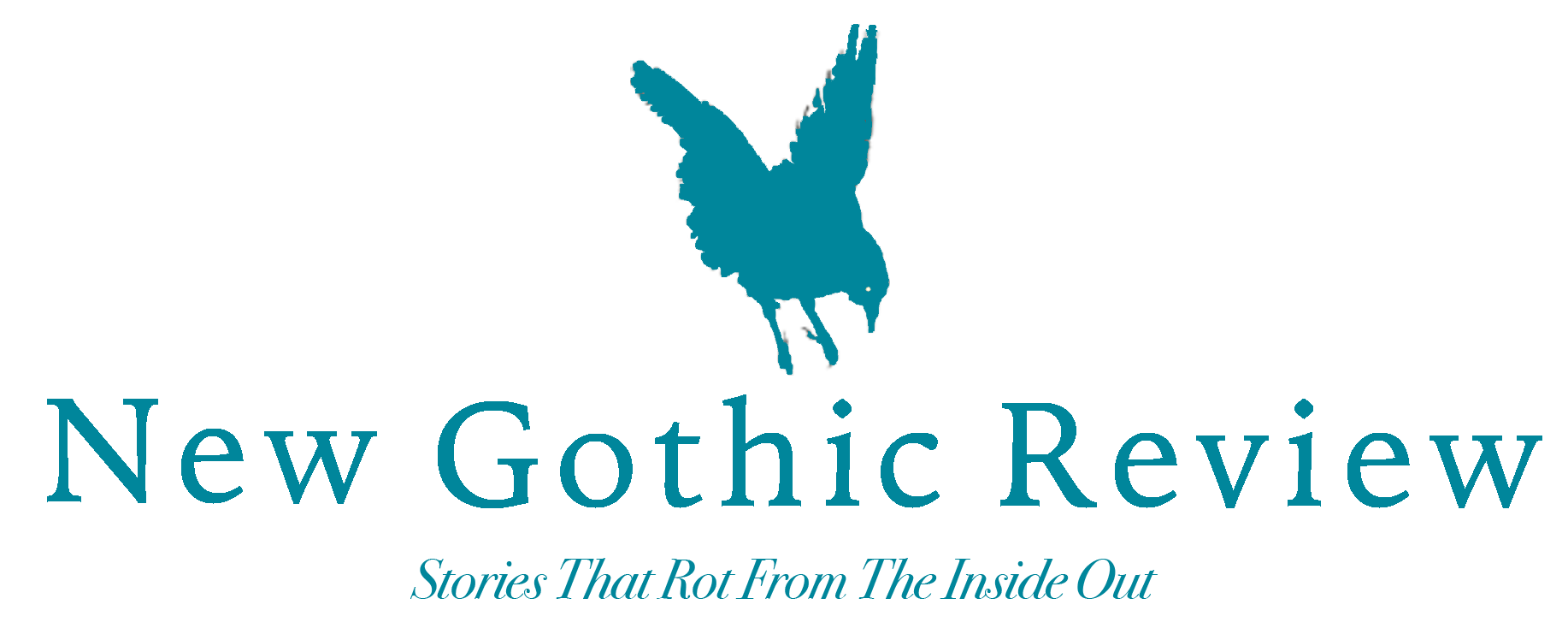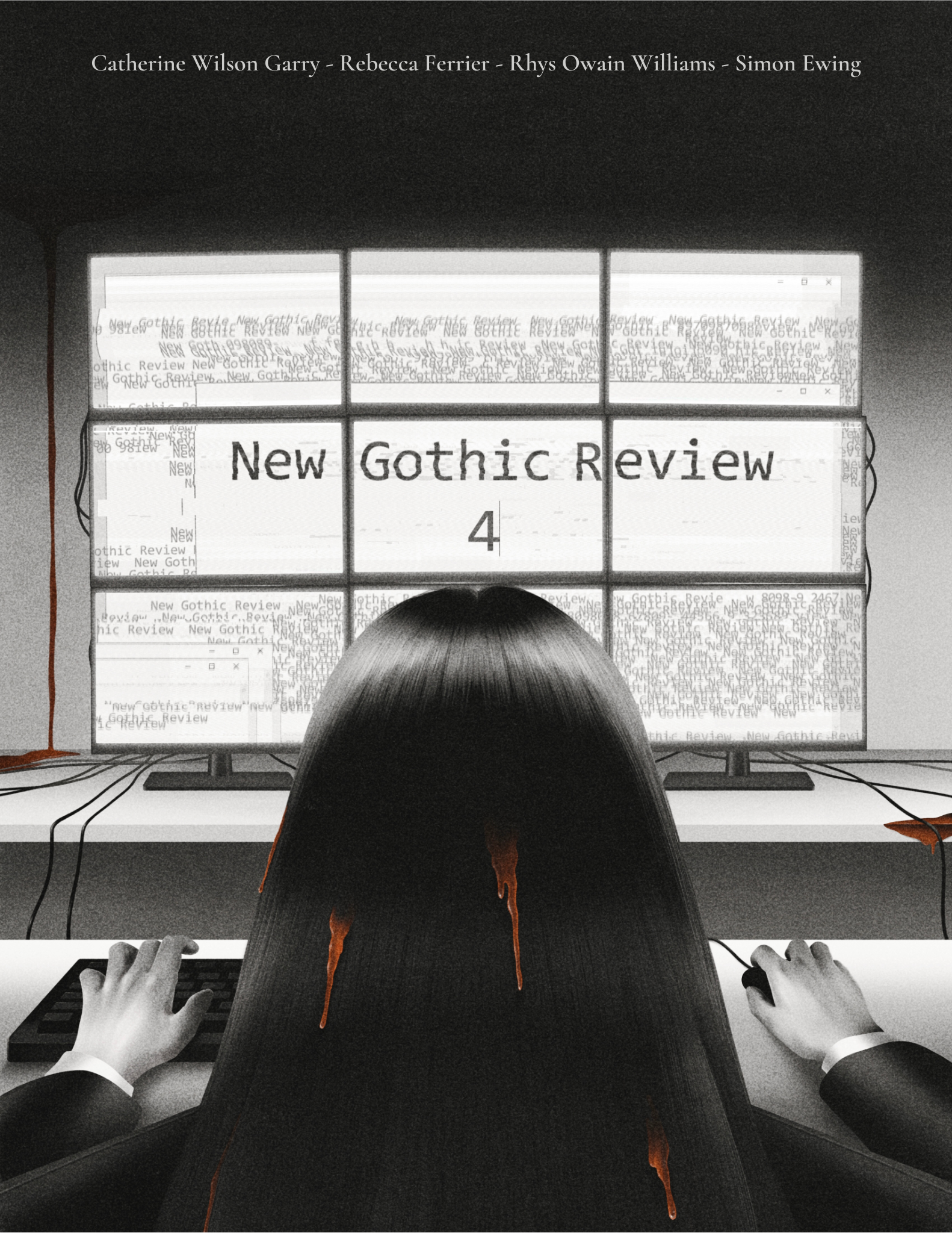Ephemera
Holly Kybett Smith

Illustration by Zuzanna Kwiecien
There’s a church on the Crest of St. Francis, though few have lived to see it.
That is, few have lived to see it with their naked eyes. We’ve all seen the postcards, glossy and inviting, peeling at the corners now. We’ve all thumbed the guidebooks sitting in a stack in the school refectory, where they’re occasionally put to use propping up the wobbly leg of a dining table—or, on the days when the nurses visit, socking each other on our newly-vaccinated arms.
The tidal island sits only a mile out from the mainland, visible from the beach on a clear day, but therein lies the problem: we don’t get clear days anymore. Not since the fertiliser production plant arrived in town, bringing with it a steady stream of jobs and a steadier stream of photochemical smog. There used to be regulations on how much a plant was allowed to pollute the local air. There is nothing like that now. I don’t remember a day in my life when I could step outside without the smog rushing to embrace me. Warm and lung-flooding, an unhealthy yellowish grey. It crowds for my attention. We missed you. We missed you.
Today, I work my rake along the beach, taking my time to pick through each layer of shingle. Beside me, a jute sack waits to be filled. I collect coffee stirrers, cigarette butts, soda cans and shreds of mutilated styrofoam. Human ephemera, not so ephemeral after all.
The Church sits out there somewhere: another thing we made and then abandoned to the sea. No-one is allowed to take a boat out in the mist, so we aren’t sure how much of it is left intact. It must have at least partially fallen into ruin. I tell myself it doesn’t matter. Someone will have excavated it already, taken and sold everything valuable inside. It may not be legal but we get plenty of unlicensed wreck divers around here. Why not a church looter, too?
That’s as much as I allow myself to think on it.
The Church has always unsettled me, and I have work to do.
As I scour the beach, I dread that I might happen across a shoe. I found one once, when I was twelve and fairly new to this job. It was the kind of shoe you might see on display in the window of a fancy sportswear shop, not the kind you would expect to find discarded in a tangle of seaweed and blue fishing wire. But I had been more curious than wary. The shoe had been lying on its side. It wasn’t until I picked it up that I saw the white bone jutting out of it.
Needless to say, I completely lost my shit.
Later, as I shuddered my way through the milkshake Luis bought for me in pity, I learned that when a body decays underwater, it may float upside down due to air trapped in the shoes. The feet can remain while the rest of the body detaches and sinks into the abyss. It was a grisly revelation. Luis—eight years my senior, and therefore, my boss—had always been cavalier about such things. Hence the milkshake, bought in a gesture of kindness but not one of empathy: God knows how he expected me to keep anything down that morning.
The milkshake had lots of little red bits in it. Desiccated strawberry, I think, but all I could see was flesh. Dead, withered flesh clinging to that shard of bone, bleached white by seawater but still blushing pink at the centre. Not human anymore—just nondescript meat. A thing. A thing I found on the beach.
“In Japan, they have this idea about ghosts—called yūrei there, you understand,” Luis said to me while I slurped on the shake. He had travelled to Himeji for a semester at uni and never failed to sneak it into conversation. “Ghosts float, right? So in Japan, they came to the conclusion that ghosts don’t have feet. Why would they? They don’t need to walk. Instead they just…trail off.”
We never did find out whose shoe it was—whose foot it was—though they sent it off for testing. Staring out to sea, I wondered where the rest of the body had gone. I pictured it drifting slowly downward through an empty world of blue, its sightless eyes still open, white flesh sloughing off its skeletonised fingers. Silver bubbles stuck to its cheeks and its eyelashes; tiny fish swarmed in through an ear and out of its yawning mouth where the bottom jaw had fallen free.
All the while, it floated without care, trailing off like a yūrei at the ankles.
“Please don’t tell me any more weird shit,” I said.
Luis snickered. “Language, kid.”
He called me “kid” because he knew I didn’t like it.
It’s been three years since he disappeared. They never found his body. The popular theory is that he went out for a swim one day and got caught in a riptide, though some have speculated that he threw himself off a cliff. I reckon I’d put up with being called “kid” all day if it meant he came home safe to his mother and sister. As I scan the beach today—sixteen and still picking litter—it’s his red trainers I dread finding the most.
Ghosts float, right?
I hope not, Luis. I hope not.
The mist is blanket-thick this morning, thick enough to render me the compass point of an island barely a metre in radius. My jute sack hovers at the edge of my vision, a misshapen lump with no distinguishable features. Beyond that, the beach could be full of strangers—watching me, surrounding me—and I wouldn’t even know it.
There is that feeling, though, isn’t there? The one you get when something’s watching you. That prickling, niggling feeling that urges you to turn around and check—just in case. If I relied on that as a barometer for danger, though, my shifts down at the beach would all be hurricanes.
See, the worst part of this job has never been the risk of finding another severed foot. It’s the mist, curling around me the way a cat curls around a leg, rubbing up against my clothes and claiming me as its own. Usually I can ignore it, but not when I’m alone. Not when I’m down on the beach.
I pull my scarf up over my mouth.
The mist here is different from the mist up on the clifftops. It breathes.
Before the shoe incident, Luis used to tease me about ghosts. Would run up at me through the mist with waggling hands and shout, “Whoooo!”
I would flinch. I still do, sometimes, if I think I hear the crunching sound of footfalls in the distance. But I could never quit.
It’s not that I enjoy this job a particular amount, though I do find nice debris on occasion. I have a collection of sea glass that I keep in a jar on my bedroom windowsill where the light can catch it and project colours onto the opposite wall: swirling blues and greens and oranges like jewels. Beside it sits the dried-out body of a seahorse—small enough to fit inside my palm—and a selection of my favourite shells: dog whelks, mussels, various bivalvia. When I’m stressed, I pick them up and run my fingers over them, feeling the grooves along their sides. Once I found an antique coin, which—after I’d cleaned it up—sold for almost thirty pounds.
If I were a more fanciful person, I might think these items were the sea’s way of apologising for the severed foot. They all washed up within a year of my finding it. Except that the sea took Luis, just days after I found the coin, and I never got an apology for that.
The truth is, I do this job because it feels right. Like I’m supposed to be here, trudging the shores from sunrise ‘til gone noon. (If it can be called sunrise, when the sun is little more than a torch beam shining through a tissue paper shroud.) My eyes have grown nimble, my hands dextrous from years of knowing what to look for. I’ve learned not to mind the ache at the base of my neck, the coastal chill through my thick homemade jumper. Even when I stray too close to the sea—when it rushes at me, soaking my socks and shoes—I can scarcely bring myself to care. I simply shed my shoes for the spare pair I keep in my backpack, and chide the mist for letting me wander so far.
The mist is eager to toy with me this morning. I don’t know how I can tell, but—like my eye for spotting half-buried debris—it’s something I’ve grown a knack for recognising. There’s a motion to it: a tiptoeing, anxious sort of motion, like a child playing a game of What’s the Time, Mister Wolf?
Perhaps I personify it that way to make it feel less scary. Because I do feel it, and it’s not the bluster of a breeze. The air is still down here, between the cliffs: still and silent. The motion of the mist is entirely its own, but what dictates it has always been a mystery.
Of all the possibilities, a child’s game feels the least threatening.
I kneel down to extricate a crab from a tangle of plastic netting—the type supermarkets used to wrap lemons and limes in, before importing lemons and limes got difficult—and the shingle bites into my knees, comfortingly tangible. I’ve had to patch over my jeans twice this year; I’d rather not do it again for a while, but the thought of what colour thread I might use is enough to alleviate some of my unease. The mist drapes itself over me as if in pity. For a moment, I allow it to lean against my back.
When I lift my head, I am struck abruptly by the sense that I’ve moved.
I’m not sure what gives me the idea. The shingle slope runs the length of the bay, and there are no markers along it. I crouch in the exact same position as before, feeling the same shifting pebbles through the worn soles of my shoes, and I just know.
I am not where I was. I am very far from where I was.
The crab scuttles out of its net and settles on the back of my hand as I stare out through the nothingness. The land is not the sea, I remind myself. No current has caught me unawares, yanked me off to one side of the bay without my noticing. When I give in and glance over my shoulder, though, my stomach drops. My jute sack and rake have disappeared. I have left them behind.
Hesitantly, I stand, as if just lifting myself away from the ground might sever my contact with it. The crab falls to the shingle with a thud. Its brown body rolls twice before I lose it to the mist. A small part of me wishes I’d kept hold of it, just for the sake of not being alone—but somehow I know if I reach for it, I won’t find it again.
When I look up, I’m almost not surprised by what I see.
There, at the far end of a tunnel through the mist, is the Crest of St Francis. At its peak sits an old stone church, its silhouette a charcoal smudge against the mist. If I squint, I can ascertain the shape of the bell in its tower, making mournful music as it moves. The sight is blurred, but the sound of that bell rings clear across the water.
Before I even think about it, I step closer.
A boat is waiting for me at the shoreline.
The bell tolls as I row across the dull grey water.
There is no other sound.
Not the slap of waves against the wooden hull; not the plunging, gushing cycle of the oars; not the restless sighing of the ocean at large. I can hear my breath, but it’s faint—muffled—like I’m listening to it through a pane of glass. To break the silence, I hum my favourite songs to myself, stumbling with every interruption from the bell.
When I’ve run out of favourites, I hum the songs I hate. Catchy ones I’ve heard too many times on the radio. Songs from musicals I’ve never watched. Commercial jingles. Nursery rhymes. Anything. Everything I have.
The Crest sits only a mile out from the bay, yet it feels like I spend an eternity rowing out to it. My lips go numb from humming for so long. The sun sits still in the sky, a faint translucent dot in the mist. I don’t know how to tell the time by its position, but I can tell it hasn’t moved since I began my journey. As I row, the mist closes over the water I’ve crossed, until all I can see is the clear path from my boat to the island.
I’ve only lowered my head briefly—with the idea to pause and check under the bench for food—when I feel the prow bump against something solid. When I look up, I have arrived. A moment ago, The Crest of St Francis had been nothing but a foggy outline on the horizon; now, it towers over me, its dark rocks as real as my bones.
The mist has swallowed everything behind me now, but the way ahead is clear, so I clamber out of the boat and onto the rocks. I consider tying the boat off somewhere, but there isn’t a jetty, and I haven’t any rope. I could drag it up above the tide line, but it looks heavier than I am strong, and the rocks are sharp enough that they could puncture the hull.
I tell myself that that’s the only reason I leave it behind.
The Crest of St Francis is conical in shape, with convex whorls like those of a seashell. A path cuts through the rock, following the spiral to its peak, where the Church is waiting.
It takes me far less time to climb the Crest than it did to row out to it.
When I reach the top, I wager I should be able to see the whole island—including my little boat, bobbing faithfully on the waves at its shore—but all I see is the Church looming out through the nothing. Lichen crusts its walls, which strikes me as odd. Lichen acts as an environmental indicator; it only grows where the air quality is good. I don’t know why this bothers me—there are more important matters at hand—but it does.
On the Church doors, one word has been carved into the wood, roughly and recently enough that the grooves are still pale and splintered. I remember the little pocket knife Luis used to carry for freeing sea creatures from nets and wonder idly whether it was him.
ASPHODEL
If it’s in English, I don’t know what it means.
Perhaps it’s a warning.
Perhaps it’s a welcome.
The mist is pushing at my back now; pushing with splayed hands, with force. The children have almost caught Mister Wolf. It is all a game, isn’t it? The mist is a child playing, or it’s a predator. The debris I collected on my windowsill was an apology, or it was a lure.
I enter the Church, breaking the carving in half as I do. When the doors swing shut, the word will be whole again behind me, like I was never there.




